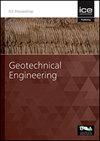刚性粘土中嵌入式挡土墙的反分析
IF 1.7
4区 工程技术
Q3 ENGINEERING, GEOLOGICAL
Proceedings of the Institution of Civil Engineers-Geotechnical Engineering
Pub Date : 2023-07-10
DOI:10.1680/jgeen.22.00072
引用次数: 1
摘要
嵌入式挡土墙在开挖期间和开挖后的性能通常使用数值技术进行预测,并通过现场监测进行评估。然而,很少对施工后监测数据进行后续的反向分析。本文的目的有两个方面:(i)对伦敦市中心一个建筑工地的现场信息和监测数据进行全面的施工后审查;(ii)详细介绍作为五个关键预埋挡土墙部分反向分析的一部分进行的参数研究的结果。参数化研究强调了在预测墙体挠度曲线时考虑非线性土体刚度影响的重要性。通过反分析,数值模型与现场监测数据吻合较好。预测的C级墙挠度曲线的差异归因于不同的临时支撑系统和复杂的3D场地几何形状。提出了有关实地监测的最佳做法建议和进行类似反向分析的新的精简方法。本文章由计算机程序翻译,如有差异,请以英文原文为准。
Back-analysis of an embedded retaining wall in stiff clay
The performance of embedded retaining walls during and after excavation is commonly predicted using numerical techniques and assessed by field monitoring. However, subsequent back-analyses of post-construction monitoring data are rarely undertaken. The purpose of this paper is two-fold: (i) to provide a comprehensive post-construction review of site information and monitoring data from a construction site in central London and (ii) to detail results from a parametric study undertaken as part of the back-analyses of five key embedded retaining wall sections. The importance of accounting for the effects of non-linear soil stiffness when predicting wall deflection profiles is highlighted by the parametric study. Good agreement between the numerical model and field monitoring data was achieved through the back-analysis exercise. Differences in the predicted Class C wall deflection profiles are attributed to varying temporary support systems and complex 3D site geometry. Best practice recommendations relating to field monitoring and a new streamlined methodology for performing similar back-analyses are proposed.
求助全文
通过发布文献求助,成功后即可免费获取论文全文。
去求助
来源期刊
CiteScore
4.40
自引率
4.50%
发文量
68
审稿时长
3 months
期刊介绍:
Geotechnical Engineering provides a forum for the publication of high quality, topical and relevant technical papers covering all aspects of geotechnical research, design, construction and performance. The journal aims to be of interest to those civil, structural or geotechnical engineering practitioners wishing to develop a greater understanding of the influence of geotechnics on the built environment.

 求助内容:
求助内容: 应助结果提醒方式:
应助结果提醒方式:


